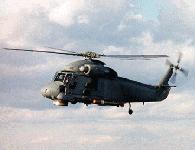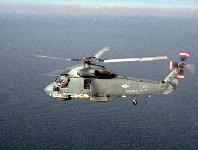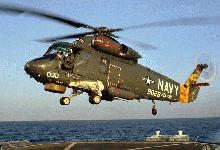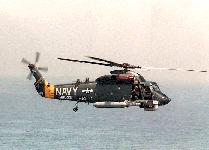Specifications
|
|
Type
| Shipboard ASW and anti-ship helicopter
|
| Program Summary |
Latest in the H-2 series LAMPS MARK I program
Entered the Fleet in 1967 and has operated from most aviation-capable
ships in the U.S. Navy and international navies.
Currently operated by the U.S. Naval Reserve Force; first delivered in
February 1993.
In 1995, the Arab Republic of Egypt contracted for 10 SH-2G
aircraft in a dipping sonar configuration. The first deliveries under this program took place in 1997.
The aircraft's low gross weight coupled with the power available
from the T700-GE-401 engines make it attractive
for small deck operations.
|
| Manufacturer |
Kaman Aerospace
Old Windsor Road
Bloomfield, Connecticut 06002
|
| Crew |
three (2 pilots + 1 aircrew)
|
| Passengers | up to 8 fully armed troops
|
| Weapons | On outriggers on the fuselage side, the SH-2G can carry
2 x Mk.46 ASW torpedo
2 x Mk.50 ALWT torpedo
Mk.11 depth charge
2 x Penguin anti-ship missile
2 x Maverick
2 x Sea Skua anti-ship missile
Hellfire missiles
2.75 inch rockets
|
| Power plant | 2 x General Electric T700-GE-401 turboshafts
|
|
Power | 2 x 1285 kW (1723 shp) contingency rating;
2 x 1690 shp for 30 minutes maximum
2 x 1437 shp maximum continuous.
|
| Fuel consumption | 0.21 kg/h/shp at intermediate power
|
| Fuselage length | 44ft (13.5m)
|
| Width | 12'4"ft (3.73m)
|
| Height | 15ft (4.62m) over tail rotor
|
| Main Rotor Diameter | 44ft 4in (13.5m)
|
| Tail rotor diameter | 8ft (2.46m)
|
|
Empty Weight | 7,600lb (3,447kg)
|
| Max Loaded Weight | 13,500lb(6,124kg)
|
| Fuel | 1800 l /476 US gal)
|
| Useful load | 2300 kg
|
| Cargo hook capacity | 1810 kg
|
| Max. take-off weigth | 6115 kg
|
| Max. level speed | 159mph (256km/h) at sea level
|
| Normal cruise speed | 222 km/h (120 kts)
|
| Max. climb rate | 2,070 feet/min with Two Auxiliary Fuel Tanks (at sea level)
1,305 feet/min with One Engine (at sea level)
|
| Service ceiling | 20400 ft (6218m)
|
| Hover in ground effect | 17600 ft (5365m)
|
| Hover out of ground effect | 14600 ft (4450m)
|
| Max. range |
450 nautical miles (with 2 auxiliary fuel tanks)
1000 km (540 NM) at 5000 ft also cited
|
| Max. Endurance |
4.5 hours at 5000 feet
5.3 hrs at 5000 ft also cited
|
|
Costs |
In 1993 the SH-2F to SH-2G conversion was quoted as $12 million.
Ten for Egypt cost
$150 million
|
|
Customers |
US Navy - 6 new (plus rebuilds from SH-2Fs)
Egypt - 10 (rebuilds)
Australia - 11 (rebuilds)
New Zealand - 4 (rebuilds)
|
 The SH-2 Seasprite is a multi-mission helicopter featuring dual General Electric T700 engines, which give the aircraft true single engine capability throughout any mission configuration and profile. Standard mission equipment in the US Navy configuration includes: the AN/UYS-503 acoustic data processor and a state-of-the-art sonobuoy processor that incorporates the best features of any Undersea Warfare (USW) equipment in the world today.
The SH-2 Seasprite is a multi-mission helicopter featuring dual General Electric T700 engines, which give the aircraft true single engine capability throughout any mission configuration and profile. Standard mission equipment in the US Navy configuration includes: the AN/UYS-503 acoustic data processor and a state-of-the-art sonobuoy processor that incorporates the best features of any Undersea Warfare (USW) equipment in the world today.






